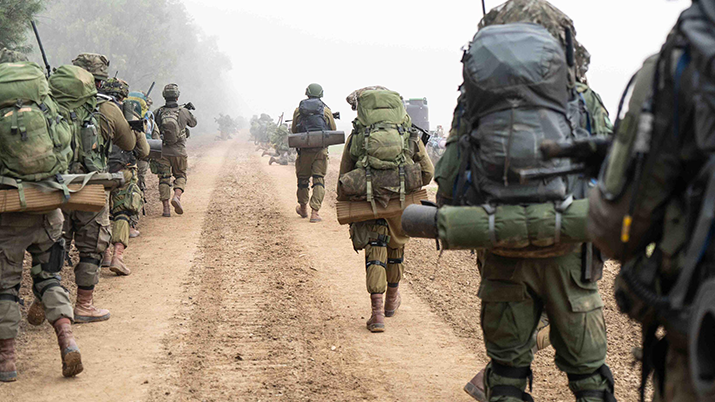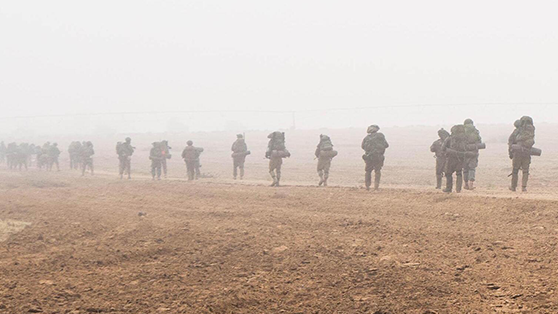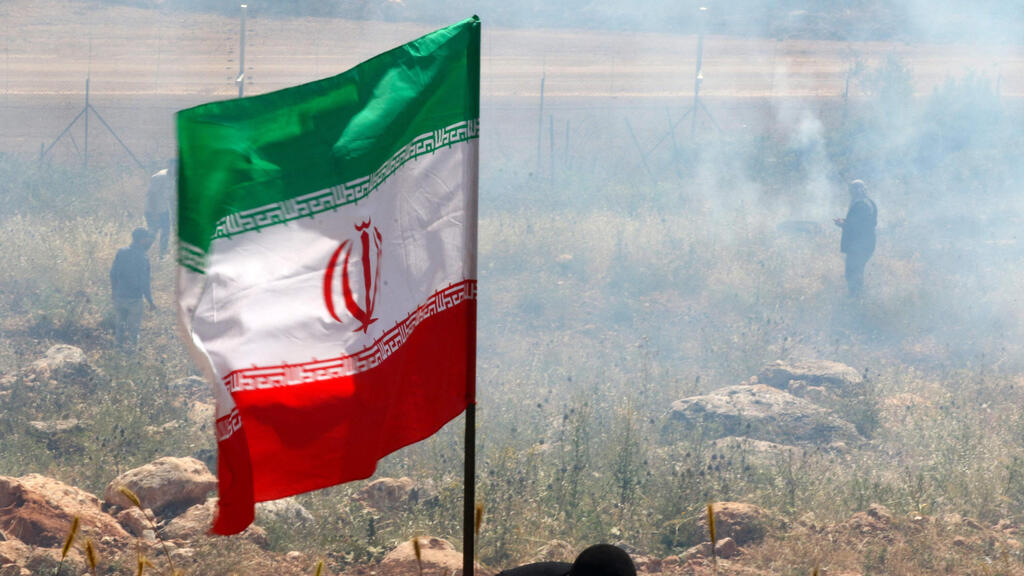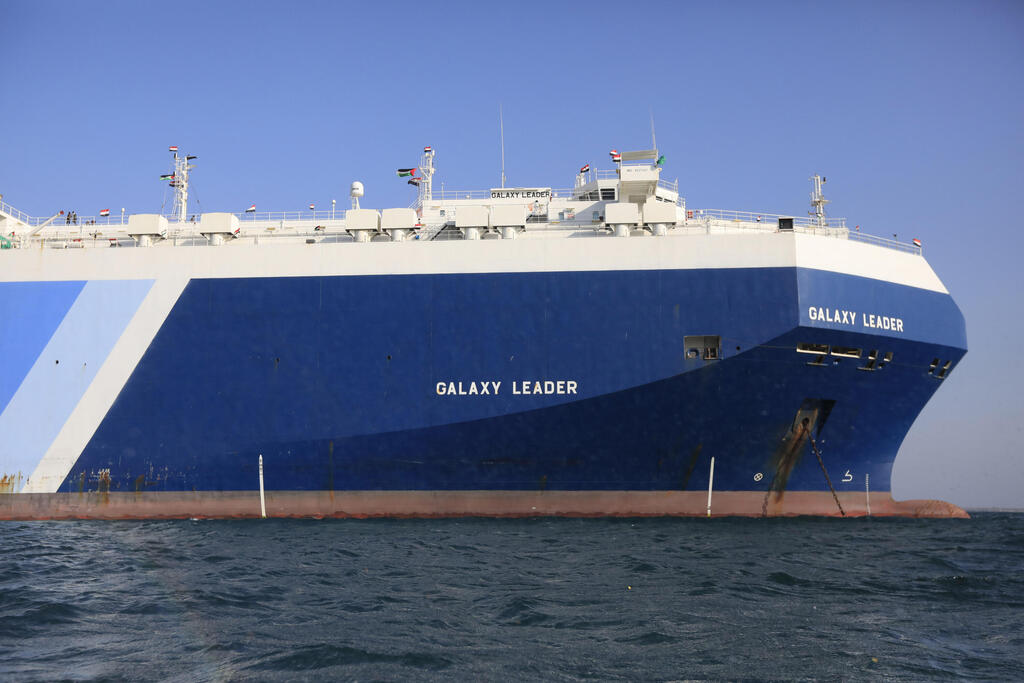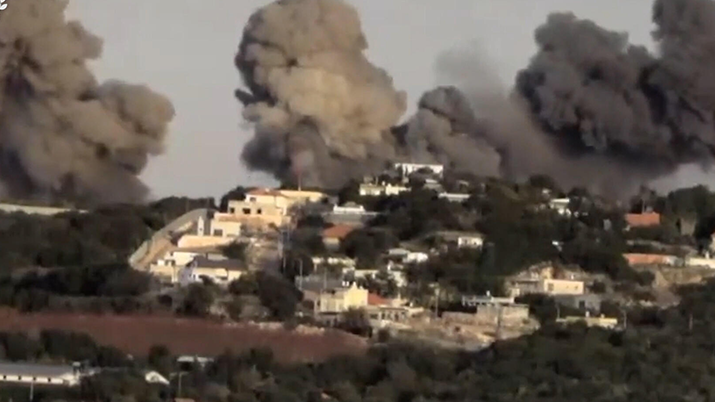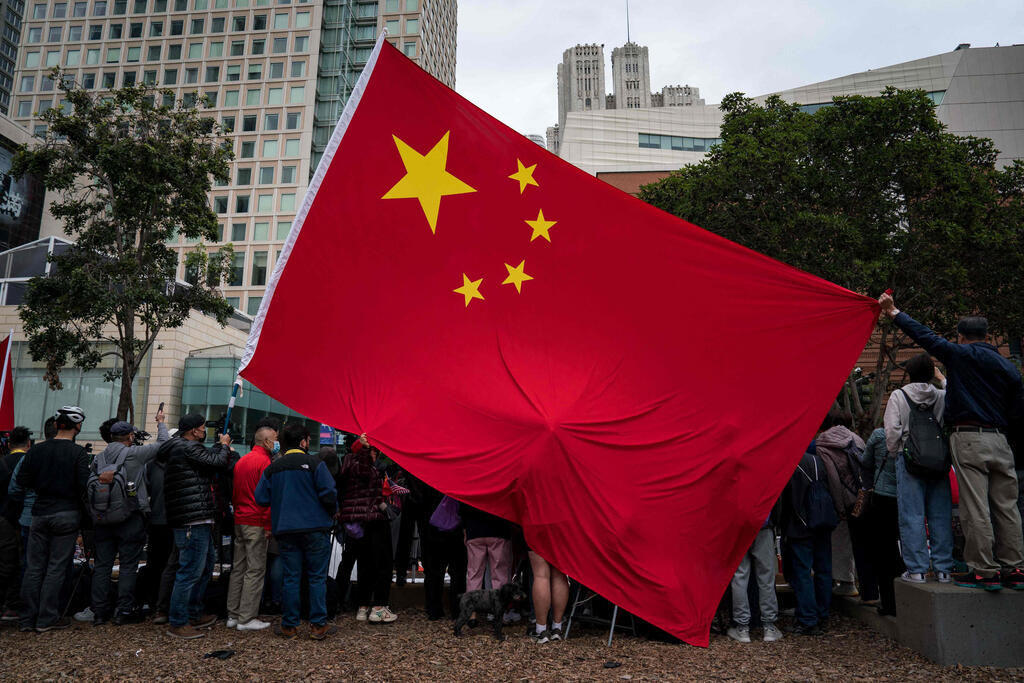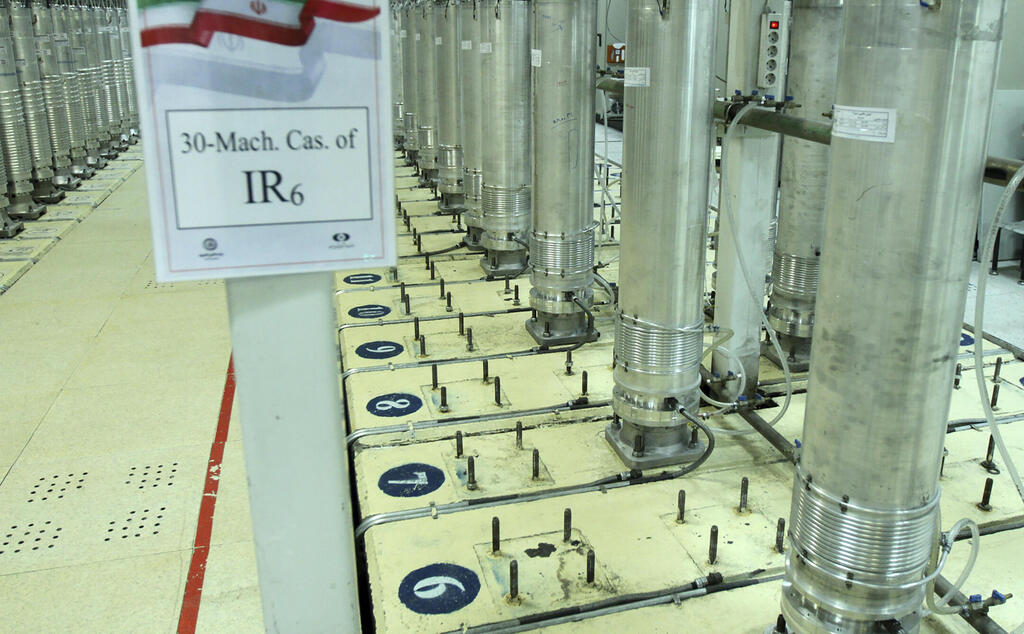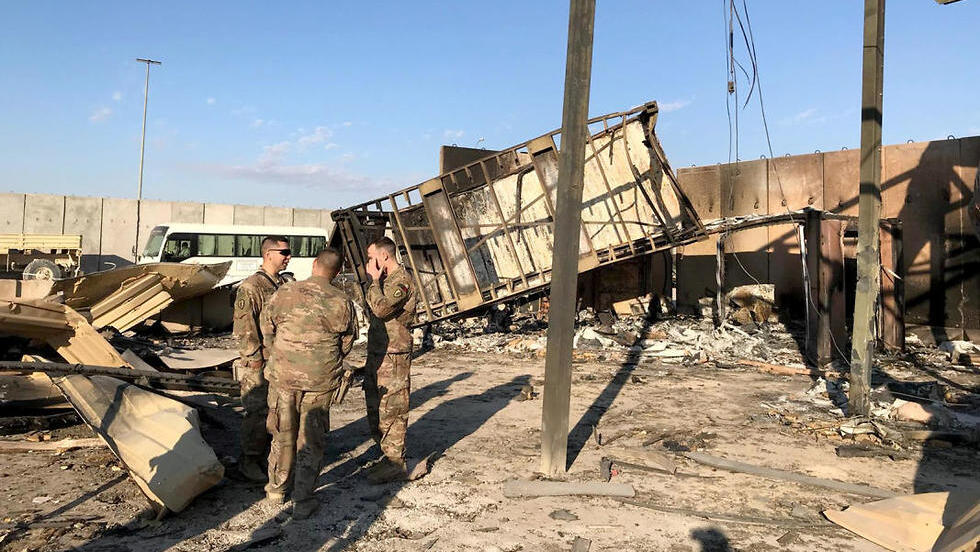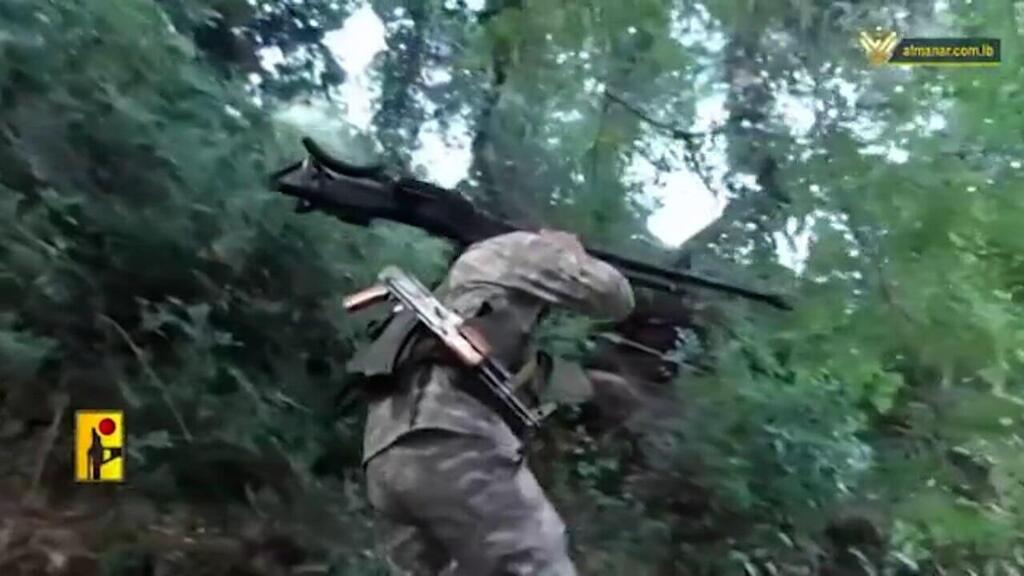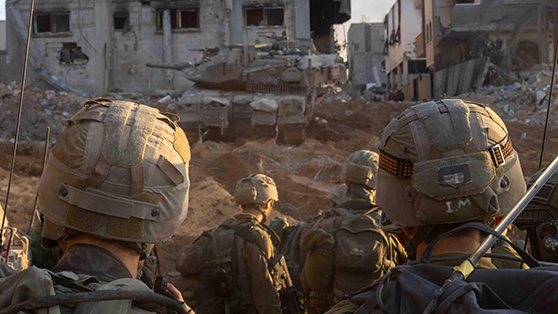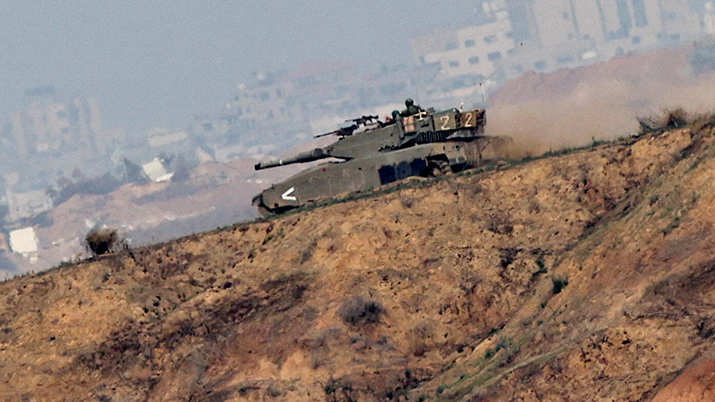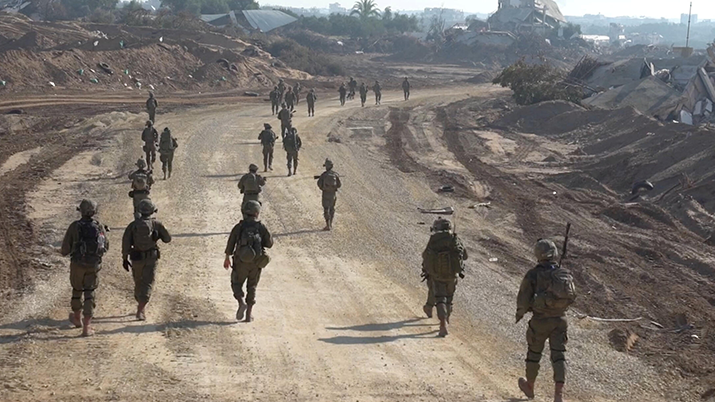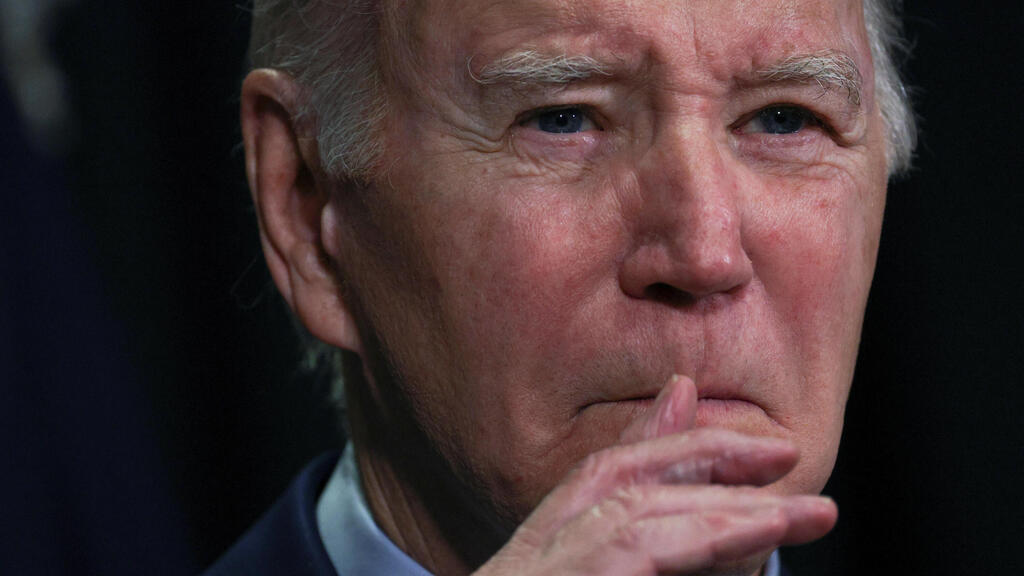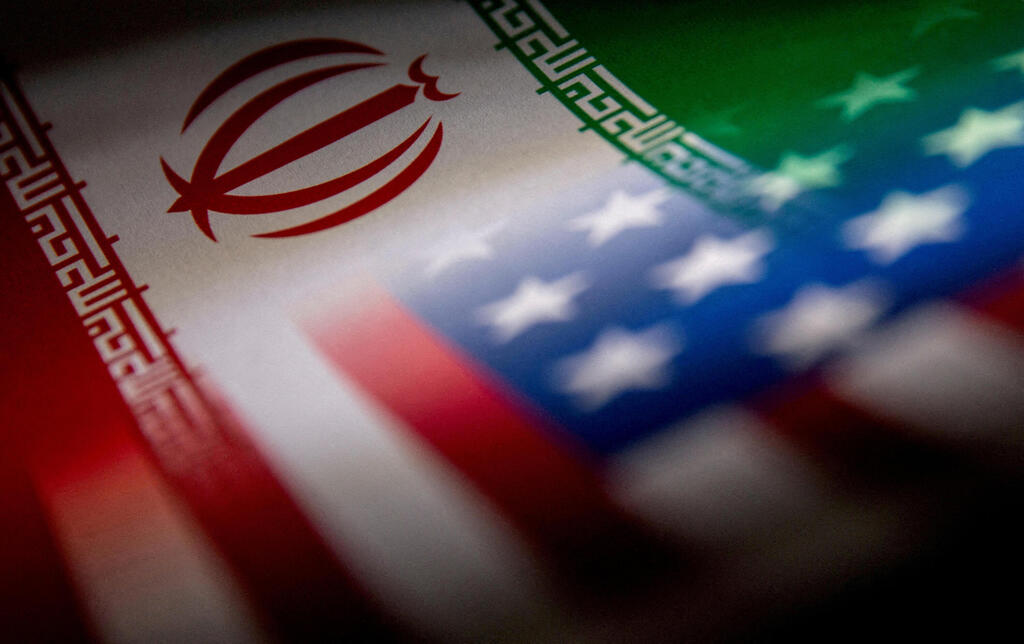Assessing the entire strategic impacts of the war in Gaza is a Herculean task. The reverberations are bound to be felt by individual countries, regionally as well as in the global arena. Some of its results will only emerge over time. Yet a few initial observations could already be offered.
More stories:
One overarching fact has reemerged. Rudimentary weapons are more than enough to cause unspeakable horrors, mass slaughter, and destruction when in the hands of a fanatical army that weaponized evil. Indeed, it may be postulated that given the October 7, experience barbarism amounts to the nuclear option of Jihadism when it comes to its extermination-causing potential.
However, unlike nuclear weapons which have been fortunately kept in reserve since WWII, barbarity has been perfected into an operational model which is not only exported, taught, and exercised but repeatedly unleashed by Jihadists against their enemies.
The conclusion is thus revalidated that intent should be given more weight than estimates of capability when it comes to threat assessment by intelligence. Accordingly, Israel’s determination to destroy Hamas is akin to the U.S. going to war twice to disarm Iraqi President Saddam Hussein of weapons of mass destruction. The roots of these campaigns are the same—a conviction that allowing an undeterrable enemy to possess any means of annihilation is courting a certain catastrophe.
The asymmetry could not be starker: Israel is faced with terrorist armies fielding limited capabilities yet limitless intent, while itself possessing practically boundless capability but (at least until October 7,) a pint-sized intent.
Another observation involves the containment ploy which is evident in the U.S.'s muted responses to incessant attacks by Iranian proxies on American forces in Syria, Iraq, and the Red Sea. The same tactic also characterized Israeli reactions to provocations along the Lebanese border and, in the past, repeated aggressions from Gaza.
In essence, this policy embraces absorbing the attacks rather than opting for retaliation. As such it assumes tacitly that responding to the offense will only escalate the fighting which in fact accepts that deterrence would fail. Thus the “containment solution” is in fact a perversion of military thinking— adopting the minimum-response route is aimed domestically instead of outwardly against the enemy. It is politically motivated rather than a strategic choice.
Iran
While both Israel and the U.S. are under no illusion as to who is pulling the strings and orchestrating many of the attacks on their targets, Iran itself has so far suffered no punishment. The immunity could be partially explained by Israel’s preference to deal with one front at the time and Washington’s cardinal interest in limiting the scope of the war against Hamas. Yet it will be a mistake to ignore Iran’s own deterrent posture as contributing to this remarkable exemption.
Indeed according to a “U.S. official” cited in Politico on December 4, “the [Biden] Administration was downplaying the seriousness of the situation in the Red Sea” where Yemen’s Houthis have attacked several ships in order to “avoid escalating tensions” with Iran.
Iran has brought into the fight all its regional proxies, in what has sometimes been described as a horizontal escalation, to demonstrate that its strategy of surrounding Israel with a “ring of fire” is an operational reality. It thus aims to signal Israel that its fate is sealed as it is confronted by a well-armed coalition of forces united under the banner of Islam and sworn to purge the region of the “usurping” Jewish entity.
However the larger the number of such Jihadist forces joining the fight, the clearer the evidence that Iran is orchestrating the onslaught. Indeed by mobilizing all its regional assets Tehran is trying to accomplish two goals: First, according to the New York Times on November 29, "[U.S.] defense officials believe that Iran is using the militia attacks to warn the United States of what would happen to U.S. troops and interests in the region if Israel broadens its campaign to encompass Hezbollah or if Israel targets Iran’s nuclear program.”
Second, employing the entire array of proxies at its disposal whitewashes Iran’s own glaring absence from the fight and convinces Hamas it has not been abandoned since a formidable network of “resistance forces” is already in place to render it military support.
In advertising on end its myriad efforts to help Hamas militarily it is trying to silence expressions of disappointment voiced by some leaders of this terrorist army who expected the Iranians and/or Hezbollah to be in the same trench with them. In response, Tehran is tirelessly working to highlight its active support for Hamas in contrast to the reverberating paralysis displayed by Hamas’s natural Arab brethren.
The inactivity of pro-Western Arab regimes in turn is certainly linked to their new appreciation of the reality of the Jihadist threat. Iran’s running the “show” overtly and covertly undoubtedly convinced these regimes that Tehran’s Islamist bloc could be redirected against them at any time.
Iran’s efforts to deter Israel from pursuing its war plans to destroy Hamas by threatening to “widen“ the conflict have so far failed. Nor is its proxy Hezbollah able to impact the IDF’s progress. Aside from forcing Israel to maintain significant forces in the north, Iran’s tactics of keeping Hezbollah attacks below the boiling point proved counterproductive. It cost this terrorist army in man and material, led to relocation of tens of thousands of Lebanese from the south while having little impact on the prosecution of the war.
As far as Iran is concerned it would have welcomed a ceasefire already on October 8, the day after Hamas caused what its Supreme Leader Ayatollah Ali Khamenei has claimed was an “earthquake” in Israel. However, now Iran is facing a growing dilemma —is it ready to sacrifice its prize strategic possession—Hezbollah— to try and rescue Hamas as the latter’s situation continues to deteriorate? Or is it ready to forsake one of the fronts it cultivated against Israel?
How certain is it that Nasrallah obeys if ordered to launch a full-scale assault in the North? Even if he obliges can he indeed make a difference in the war? Or will Hezbollah’s intervention merely force U.S. President Joe Biden to make good on his warning of “Don’t!”
Currently, there are signs the mullahs will rather activate their militias in Syria and possibly Iraq against Israel rather than test all of these unknowns. These indications have grown stronger given that the missile and drone attacks by Yemen’s Houthis and even their hijacking of an “Israeli “ ship the Galaxy Leader in the Red Sea have failed in their efforts to divert the IDF from its main mission of crushing Hamas.
On top of it, the mullahs must be deftly worried that the IDF would turn to deal with Hezbollah once it vanquishes Hamas. In fact Iran’s Foreign Minister Hossein Amirabdollahian in an interview with Iranian television on October 16, vowed that “the leaders of the resistance will not allow the Zionist regime to do whatever it wants in Gaza and then go to other fronts of the resistance…If we do not defend Gaza today, tomorrow we will have to deal with the phosphorus bombs of the regime in our own hospitals. An opportunity has been obtained for us to stop the Zionists inside their own home."
Judged by the hectic traveling of various Iranian officials to regional countries, there is no question that Hamas has put Tehran in a bind. As long as there is no ceasefire, the mullahs face the prospect of losing one and perhaps two of the fronts hailed by them as constituting the “ring of fire” around Israel. Indeed the recent intensification of IDF operations in the West Bank may end up preempting a third such Iranian front from taking shape.
Iran’s credibility and its entire proxy strategy are suddenly at stake
Naturally, Iran is working hard to escape the trap Hamas has inadvertently laid for it. Iranian leaders are increasingly trying to deflect any pressures for them to act directly by claiming that Hamas is victorious in the war. For example, Iran’s official mouthpiece IRNA quoted Khamenei on November 19, as declaring during a speech at an Islamic Revolutionary Guard Corps (IRGC) aerospace force centre, that “the defeat of the Zionist regime in Gaza is a fact."
This claim was subsequently echoed by Iran’s President Ibrahim Raisi. Iran’s Tasnim News Agency cited him as telling a meeting of Iran’s Assembly of Experts on November 23, “If we want to make an analysis after over 40 days,… we must say that the enemy suffered a humiliating defeat and that the Palestinian people and resistance scored a great victory.”
Simultaneously and perhaps ironically the Iranians were also lobbying for a ceasefire so as to resolve their dilemma. For example, Foreign Minister Amirabdollahian warned in an interview in the Lebanese broadcaster Al Mayadeen on November 22, that “if the truce between the Hamas and Israel is not extended, the war will spread across the Middle East.” President Raisi issued a similar warning in his address the next day.
Of course the pause in the fighting and the release of Hamas prisoners was at least a temporary respite for Iran in its effort to extricate itself from the corner Hamas had put it in. The Hindustan Times on November 23, cited Raisi as rushing to declare that Hamas won because the IDF ceased fire without achieving “any” of its war objectives. He said the IDF “failed“ to meet the objectives of occupying Gaza by eradicating Hamas. Raisi further praised Hamas, saying it demonstrated a “golden scene of resistance” in the war.
Yet it is likely that at least some of Iran’s regional proxies have by now realized they can expect scant protection from the “mother ship” once they are confronted by their enemies. At most they could expect a symbolic military support from one or more of Iran’s other regional proxies.
Iran’s longstanding preference for a proxy strategy strongly suggests an effort to avoid any direct confrontation which could threaten the regime’s hold to power. Thus, with the exception of the hijacking of the “Israeli “ ship in the Red Sea by Yemen’s Houthis, the intervention by Iran’s proxies in the war was exclusively long-range— i.e. it was limited to the firing of such weapons as missiles, rockets,drones and mortars— but avoided committing “boots on the ground.”
In so doing, Iran opted for a geographical escalation but kept its proxies’ involvement qualitatively limited. The war has so far demonstrated the limits of Iran’s risk taking which in turn exposed the fragility of its strategy to expel the U.S. from the Middle East and extend its zone of influence there by using proxies.
Tehran is faced with an important dilemma— unless it is ready to commit its own forces to defend its expanding zone of influence its credibility will be destroyed and so will the incentive of its proxies to do its bidding. Yet joining the fight in earnest would not only jeopardize the viability of its long-cultivated surrogates, but more importantly could threaten its oil industry, its nuclear program and very likely the regime’s stability itself.
In fact, Tehran seems to be avoiding any entanglement that could bring the war to its home turf and disrupt oil exports that are finally recovering after U.S. sanctions depressed Iran’s sorely needed oil revenue. The mullahs know full well that any provocation linked to Iran directly could cause American or Israeli retaliation that, at a minimum, imperil shipping lanes and oil production facilities in and around Iran.
In this regard the role of China must be mentioned. China, the world's largest crude importer and Iran's top customer, bought an average 1.05 million barrels per day (bpd) of Iranian oil in the first 10 months of 2023, according to shiptracking data from Vortexa.
This is 60% above pre-sanction peaks recorded by Chinese customs in 2017. (The exact quantity could be even higher given that much of the oil that was shipped from Iran to China was relabeled as originating from countries such as Malaysia, the UAE and Oman to avoid sanctions.)
Beijing could therefore have more influence over Iran than the United States’ warnings do — and China wants the spigots open so oil prices remain low. This vital economic interest is equally shared by the mullahs and would strongly militate against the Islamic Republic joining the war which is paradoxically in line with American and Israeli strategic interests.
In sum, it appears likely that Hamas’s future is going to be decided in the Iranian bazaar after all.
As well, the longer Iran’s adheres to its strategy of “covert involvement” it operationally acquiesces in the IDF’s plan of handling one front at a time which would only aggravate its dilemma.
Worse yet the greater is Israel’s victory in Gaza the higher the likelihood that it would turn its attention to Iran’s strategic threat.
Thus, and most importantly, the impact of the war on Iran’s nuclear program must be considered. There should be little doubt that at least some Iranian mullahs are now convinced Iran must acquire nuclear weapons and the sooner the better. (Leak from the most recent IAEA’s report on Iran’s nuclear program indicated nuclear violations by the Islamic Republic and progress have reached new highs.)
They probably contend that if Iran was armed with nuclear weapons it could have provided more support for Hamas and exploited a golden opportunity to erase Israel off the map. Also, Washington would have thought twice before rushing to Israel’s aid and deploying a strategic umbrella over the IDF’s offensive in Gaza. They may fear Israel and the U.S. are colluding to roll back Iran’s regional strategy and that America’s beefing of forces in the Mediterranean and Persian Gulf regions are meant to deter Tehran and allow Israel to deal with Hezbollah unhindered.
At the same time it could be convincingly argued that the revamped U.S. regional military posture is also meant to deter Tehran from any breakout to the bomb while Jerusalem and Washington are preoccupied elsewhere. In this sense it is still too early to assess whether the American strategic deterrent is effective.
The United States
The growing belief that America has shifted its strategic interests away from the Middle East has spurred its enemies to move aggressively to fulfill the perceived power vacuum. The war in Gaza demonstrates convincingly that even the impression that the region is no longer a strategic priority in Washington’s calculations has had dreadful consequences.
The war also raises questions as to the U.S. deterrent capability. Despite stern warnings by a host of American officials, Iranian proxies all across the region have intervened militarily in the conflict. Moreover, Iranian militias in Syria and Iraq and the Houthis in Yemen have repeatedly attacked U.S. military assets in the theater.
Hezbollah it appears is calibrating the frequency and scope of its attacks on Israel not by the gravity of Washington’s warnings but by its assessment of how dire is Hamas’s situation in Gaza. In fact it seems that the tepid response of the U.S. to the nonstop attacks on its bases in Syria and Iraq by Iranian militias has emboldened Nasrallah to escalate his involvement in the war.
The Washington Post on November 19, said “frustration [was] building within the Department of Defense (DoD), officials say, over the surge in Iranian proxy attacks on American military positions.” The paper added that a “ split” was emerging between the Pentagon and the White House as the latter was “struggling” to deter the escalating attacks and the DoD blaming the “soft hand” policy of the administration for the worsening situation.
The age old dictum has been reaffirmed—the larger and more conspicuous is a power’s regional military deployment the more likely it is to be branded a “paper tiger” if it fails to use it once its deterrent signals fail.
In their defense Biden Administration’s officials have argued that the fact that Hezbollah has refrained from a full blown intervention in the war and Iran’s role is limited to activating its proxies while skirting direct involvement altogether are testimonies to the effectiveness of the U.S. warnings.
Such claims are debatable, however. For instance it cannot be determined to what extent is Nasrallah indeed deterred and to what degree he is dissuaded by considerations of internal Lebanese politics and domestic restraints.
Indeed Reuters on November 14, quoted “one source [close to Hezbollah]” as disclosing that “ Hamas wanted Hezbollah to strike deeper into Israel with its massive arsenal of rockets but that Hezbollah believed this would lead Israel to lay waste to Lebanon without halting its attack on Gaza.”
As for deterring a direct Iranian intervention it must be noted that Tehran’s penchant for operating through proxies long predates the Gaza war. The claim that this indirect modus operandi is due to specific U.S. warnings cannot be easily substantiated.
Further, the minimalistic American response comes although Iran wants to fuel the Gaza war and turn it into an anti-U.S. campaign so as to erode its standing in the region. The wider the conflict and the weaker America’s response the less credible will it defense guarantees be in the eyes of its regional Arab allies who are as concerned about the Iranian threat as is Israel.
In fact, while Israel seems capable of handling Iran’s proxies quite effectively, America’s regional Arab allies might see a U.S. defense guarantee as a sine qua non for their very survival and feel less than reassured by the Biden Administration’s cautions conduct.
Ironically the only target where the U.S. efforts at deterrence seems to have had an effect was on Israel. It has been reported that the Biden Administration’s “nightmare scenario” involves the possibility of an all out war in the Middle East during the upcoming elections in the U.S.
Accordingly the reason for the U.S. special envoy Amos Hochstein’s hurried visit to Israel in late November was to push to contain the cross-border violence with Hezbollah on Israel’s northern border and the budding conflict with the Houthis in Yemen.
The White House must have been unnerved by the IDF’s buildup in the north and the growing pressures within Israel to launch a preemptive attack on Hezbollah details of which were also reported by the Wall Street Journal on November 21.
Not surprisingly, for its part Hezbollah has acted to elevate the specter of a conflagration. For example Naim Qassem, Hezbollah’s second in command, said on November 21, that “the possibility of war [ in the north] exists as long as the aggression against Gaza continues.”
In retrospect it has become clear that the quick reaction of the Biden administration in support of Israel while commendable was also aimed at gaining a foothold in Israeli decision making. Washington’s aid did not come free of charge after all.
It provided the Americans with leverage vis-a-vis Jerusalem which ensured it has had a seat at the table on every issue including the conduct of the war against Hamas, containing the fighting against Hezbollah, the release of hostages, establishing humanitarian aid corridors for Gazans and pressing Israel for a plan for “the day after.”
The pressure exerted by Washington on Israel to extend the pause in fighting into a longer ceasefire with Hamas cannot be viewed as in line with Jerusalem’s strategic interests. It is certainly in Hamas’s interest as well as that of Iran and will provide a material boost to its “axis of resistance.” Indeed a prolonged cessation in the fighting could allow Hamas to emerge from the war as a viable entity in contradiction to the security interests of the U.S.
Israel’s restraint toward the daily attacks in the north, it transpires, is not only reflective of its desire to engage one front at the time. It is aimed to placate Biden and avoid putting his presidential candidacy in jeopardy. Yet the price of this accommodative policy could be very steep indeed for both countries.
18 View gallery
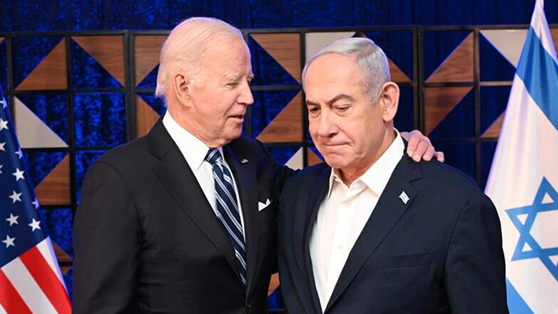

ראש הממשלה בנימין נתניהו פגישה עם נשיא ארה"ב ג'ו ביידן ב תל אביב
(צילום: חיים צח, לע"מ)
Israel
By agreeing to a pause in the fighting with Hamas Israel in effect helped bail out Iran from its growing predicament of rescuing Hamas from certain destruction or risk losing one of the main fronts it was cultivating against Israel and possibly sabotaging its entire proxy strategy.
In the wake of October 7, the long held Israeli policy of quiet-for-quite has hopefully been buried for good. Similarly the concept of deterrence has become a taboo in Israel.
Instead the IDF’s has reverted to an offensive strategy and impressive muscle-flexing to intimidate enemies and reassure a deeply unnerved Israeli population of the steadfastness of their ultimate defender.
Moreover, there should be little doubt that the devastation inflicted on Gaza is also aimed for the eyes of Israel’s other enemies. As Israeli Defense Minister Yoav Gallant declared on November 17 while on a tour to the HQ of the 98th Division “The fighting to defeat Hamas is local fighting, but there is a Middle Eastern projection. If [for] the murder, killing and kidnapping of 1,500 children, women and civilians [we] did not [exact] a dramatic toll - the destruction of Hamas as an organization—anyone else in the region will think about trying us."
Therefore, the results of the action should be twofold. One, a tactical achievement and result[s] on the ground. And the second thing, influence and broadcast to anyone who wants to test the State of Israel in the future. A total victory in this war will lead to the exclusion of future wars for a long time to come.”
It is difficult to assess if this approach met its objective. Remarkably the Israeli public itself doubts that the Netanyahu government will indeed pursue its stated war objectives. Credibility is a major strategic asset yet difficult to restore given that past operations against Hamas ended prematurely despite similar vows.
Still, Hezbollah’s avoidance of an all-out assault suggests that the beefing up of the IDF’s posture along the Lebanese border combined with its quick and deadly responses to its attacks may have produced a deterrent impact in Nasrallah’s mind.
Of course, by continuing and even escalating those attacks Hezbollah is laboring hard to demonstrate the exact opposite - i.e. that it is not deterred and that Iran’s “unified fronts” strategy is more than just hot air.
The good news is that the Gaza war has conclusively shown that Iran’s proxy armies are incapable of seriously challenging a hi-tech military like the IDF. This is especially true considering the latter’s impressive employment of a combined-arms tactic on the battlefield.
Indirectly this imbalance is confirmed by Iran’s intensive efforts to assemble and coordinate several fronts to face up to the IDF which conveys the mullahs’ recognition that none of the fronts by itself is capable of confronting successfully the Israeli military.
In turn, it becomes ever clearer that the psychological warfare unleashed by Israel’s regional enemies day in, day out was successful in blowing out of any proportion their capabilities and thus intimidating Israel. Although in the wake of the October 7, attack the diabolical intents of these terrorist forces were made bare, and their capacity to engage in protracted attrition war and exact a heavy price from “the Jews” is undeniable, the current fight strongly suggests that Israel has increasingly been the subject of self-deterrence.
Moreover if the IDF is able to successfully accomplish its stated missions in the war and eradicate Hamas’s military and governmental structures, it would signify that the strategy of embedding terrorists’ military assets among the civilian population might have run its course. However, it must be stressed that it is the monstrosity of the October 7, attack which has so far provided the IDF the international legitimacy to pursue its operational goals.
Therefore, the Jihadist war-fighting manual of exploiting the( Western) laws of warfare as a force multiplier is unlikely to change. Given these terrorist armies’ military inferiority it is difficult to see any of them adopting a different warfare doctrine if it survives to fight another day.
In fact it may be said that Hamas’s offensive weapons—the thousands of rockets fired at Israeli cities as well as its anti-tank, mortar fire and attacking drones used against the advancing Israeli troops—have produced scant results.
They could not sway Israel from its war goals nor slow let alone halt the IDF’s offensive. In contrast Hamas’s defensive weapons— the burying underground across the entire Strip of most of its military infrastructure shielded by some 1.5 million civilians as well as the taking of hostages which enabled the relentless conduct of psychological war—have proven quite impactful regarding Israel’s war plans.
(In actuality the layout is even more preposterous. The deeper the IDF advances into Gaza the stronger the evidence that a vast number of ordinary civilian structures were either booby trapped, housed tunnels’ shafts—by December at least 800 were discovered near or within schools, kindergartens, mosques and playgrounds—or used for military purposes ranging from holding weapon caches to rocket launchers.
Consequently it would be more appropriate to describe Gaza’s above-ground residences as a camouflaged military camp shielding a vast underground military complex. According to an Israeli “security source “ quoted in the Financial Times on December 5, the latter was “more extensive than the London Underground” and in fact amounted to subterranean “cities.”)
Simultaneously, it must be said that while the IDF is successfully engaging its enemies on four fronts currently, it has been embroiled in hi-intensity conflict in only one which in itself could be viewed as a strategic achievement of the first degree.
The only potentially effective tactic in Iran proxies’ possession is to prolong the fighting. Their deliberate embedding among the civilian population which necessitates the engagement in urban warfare is meant to guarantee that the clock of international legitimacy will run out on the IDF.
The latter will be forced to fight a complex and protracted campaign entailing significant losses among its ranks and Gaza’s noncombatants. Hamas hopes the “blood bath” will enable it to survive to fight another time.
Once again Israel has learned that having a superpower for an ally provides immense strategic benefits. Yet it also involves significant costs given that the national security interests of the latter span across the globe and in turn generate the need to satisfy a variety of considerations.These concerns do not necessarily coincide, and often clash, with the ones of the junior partner.
Consequently, during the Gaza war Israel had to swallow some bitter pills for the sake of maintaining the alliance and continuing to benefit from the military and economic support of the U.S. While coming to Israel’s aid immediately in its time of need was exemplary, the Biden administration was determined to use its crucial assistance to exert tight controls on Jerusalem.
At times this posture has bordered on intrusiveness as Washington’s prime interest was and continues to be preventing the war from spreading and turning into a regional conflagration. The Americans are concerned such a development could force the U.S. to get involved at an inopportune time given its role in the Ukraine war and its main strategic concern of containing the rising challenge posed by China.
Biden’s reelection calculations also weigh against another military entanglement in the Middle East. However a heavy handed American policy could backfire if it ended up preventing Israel’s from realizing its stated war aims—an outcome which could not be in the U.S. strategic interests either.
Judged by recent declarations, Israel has already adopted a doctrine of Never Again Is Now which in theory at least would suggest important implications for its current “bomb- in-the- basement” posture. A U.S. which constrains the IDF’s exercising its conventional superiority to achieve those outcomes Israel considers indispensable to its long-term security would only push it to rely more on its ultimate deterrent.
There should be little doubt America’s boosting its conventional capabilities in the region and in effect spreading a strategic umbrella over Israel is meant to block any Israeli resort to its nuclear option under the growing belief of its leadership that the country’s very survival is at stake.
Washington’s new urgency in reaching a political settlement to the Israeli-Palestinian conflict is thus not only linked to its fear that another firestorm would divert it from its primary strategic challenges but to the nightmare of an escalation to unconventional arms. As such a widening rift between it and Jerusalem can be anticipated given the latter’s growing consensus that the October 7 attack proves there is no partner for peace.
At the same time in the wake of the war the determination of Israel to stop Iran from going nuclear must be considered ironclad. The war has bared the precarious strategic situation of Israel on the one hand and debunked any idea that Israel can live with a nuclear Iran through exercising effective deterrence on the other.
The political and diplomatic implications of this conviction for Israel’s relations with the U.S. could also be significant. At the minimum Israel may demand the U.S. bolsters its military presence around Iran, including the permanent stationing of a carrier strike force, to deter the mullahs in lieu of launching a preemptive strike against Iran’s nuclear installations.
18 View gallery
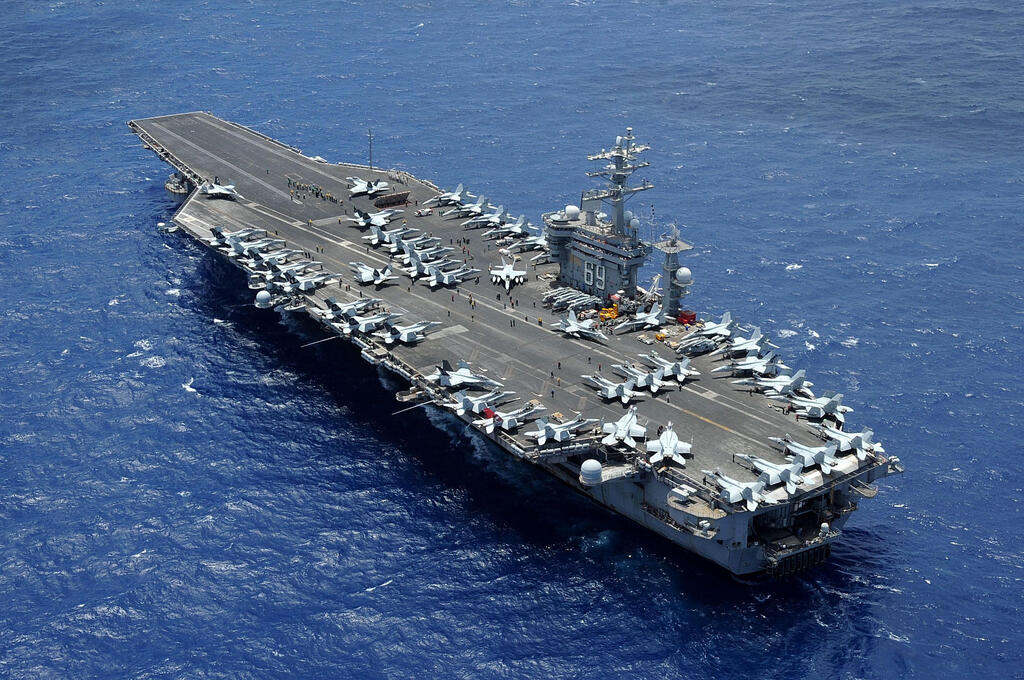

USS Dwight D. Eisenhower aircraft carrier
(Photo: AFP PHOTO / US Department of Defense/US Navy/Mass Communication Specialist 2nd Class Ryan D. McLearnon)
What’s next
The Gaza war proves that in the Middle East quiet can be transformed into total war literally over night. The wave of normalization of relations between Israel and Arab countries had not altered this unfortunate reality and might have even aggravated it by spurring Iranian efforts to scuttle the realignment of regional forces.
The war proved again that more than any nation on earth, Israel’s survival is directly linked to the quality of the intelligence it possesses regarding its enemies’ plans. Information which has accumulated since October 7, leads to the inescapable conclusion— Hamas knew more about the IDF’s than the latter knew about one of its main enemies.
While taking personal responsibility for the catastrophic intelligence failure is commendable, resignation of a few intelligence chiefs will not fix the endemic problems the October fiasco has unearthed. A wholesale revamping of Israeli intelligence collection and analysis must be carried out expeditiously.
Moreover, according to the London-based Guardian on December 4, the “Israeli military [after] examining vast quantities of phones, notebooks and documents seized from gunmen on the battlefield and in Gaza, concluded [that] Hamas engaged in years of planning, drawing up detailed maps with the help of spies inside Israel ahead of the 7 October attack.” If so, Israel’s counterintelligence operations seem woefully lacking as well.
Additionally the ability of Hamas to achieve strategic surprise should have major implications for Israel’s standing order of battle, its operational doctrine, training and readiness.
The war against Hamas is also the first time Iran’s proxy strategy has been confronted heads on. The fight indicates the fundamental weakness of the Iranian scheme. In essence Tehran’s proxy strategy is a counter-deterrence ploy designed to avoid a full blown clash while still conducting a campaign of attritional attacks capitalizing on Israel’s and the U.S. desires to avoid escalation.
18 View gallery
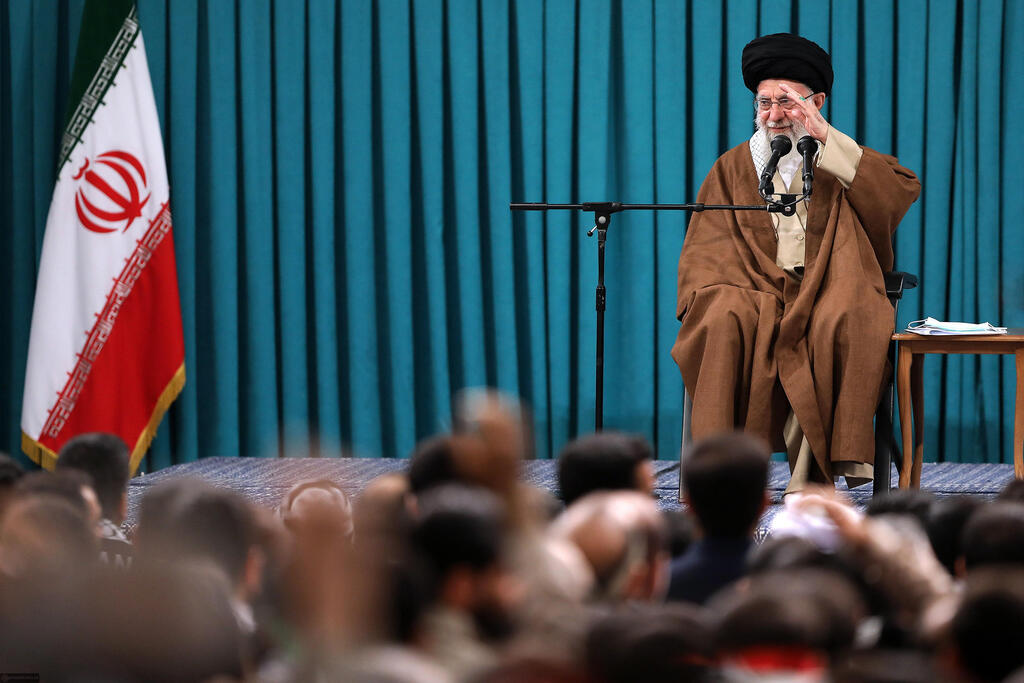

Iranian Supreme Leader Ali Khamenei
(Photo: EPA/IRANIAN SUPREME LEADER'S OFFICE / HANDOUT)
So long as it was able to exploit Israel’s abiding interest in minimizing military losses, Iran’s proxy strategy seemed on a winning path. It was continuously chipping away at Israel’s deterrent posture and put into question the military supremacy of the IDF. The net effect was to invigorate Israel’s enemies and undermine the confidence of Israelis in the guarantor of their survival.
However, in its core the mullahs’ “axis of resistance “ hinged on Israel abiding by the unwritten rules of the protracted attrition war waged against it. Iran’s strategy of wearing Israel down was in the final analysis dependent on the latter’s continuing to “dance” this “dans macabre” in the name of maintaining quiet.
The monstrosity of the Hamas attack abruptly stopped the “music.” In an instant Israel was forced to switch from “containment” to an all out offensive. The transformation exposed the basic reality— the “axis” is incapable of putting more than a token “resistance“ when pitted against the full force of the IDF.
Tehran found out it cannot prevent Israel from following its own timetable and tackling one front at the time. Even if Iran’s proxies fully commit all their forces and act in unison in a conflict against a formidable military machine like the IDF it is unclear that they can accomplish their declared goal of destroying “the Zionist occupiers.”
This is especially so if the U.S. provides a strategic umbrella aimed to neutralize a direct Iranian intervention. Besides as long as Israel maintains its monopoly on unconventional arms such an outcome is a pipe dream.
The tables have been turned. Instead of squeezing and increasingly intimidating Israel, Tehran found itself rushing, yet so far unable, to extricate its proxy strategy from collapse.
This somewhat optimistic conclusion regarding the deficiency of Iran’s master plan and the limited nature of the threat to Israel’s survival would change dramatically were Iran to acquire nuclear weapons. Such a development could nullify the impact of an American strategic shield and of Israel’s last-resort deterrence.
Thus in the wake of the Gaza war Iran would need to reassess the merits of its strategy for achieving a region obsequious to its national security interests by using proxies to spread its influence. While abetting terrorist armies to realize this goal may be effective against weaker opponents, such as vis-a-vis some neighboring Western leaning Arab states, confronting a regional superpower like Israel is certainly out of its realm. As long as this remains so an Iranian grand design for the Middle East will be hard to realize.
Indeed the catastrophic Hamas attack of October 7, presented Israel and the U.S. with a unique chance to effectively derail Iran’s malign plans and cutoff its Jihadist tentacles in the region and beyond. Squandering this opportunity would be a colossal strategic blunder.
- Dr. Avigdor Haselkorn is a strategic analyst and the author of books, articles, and op-eds on national security issues.



